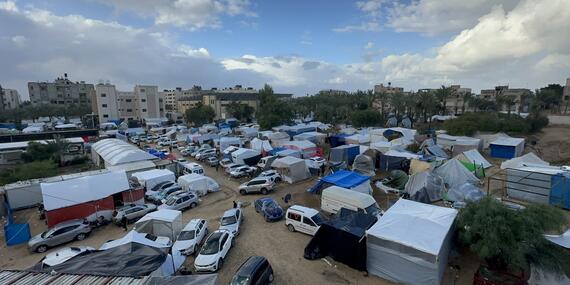Today's top news: Occupied Palestinian Territory, Myanmar

Occupied Palestinian Territory
The Humanitarian Coordinator, Lynn Hastings, says the UN and our humanitarian partners stand ready to seize this opportunity of the agreement reached by Israel and Hamas to increase humanitarian operations wherever people in need are.
She stressed that the parties need to allow for humanitarian operations to be conducted across the Gaza Strip where people are in need, especially in the north.
Yesterday, 63,800 litres of fuel entered Gaza from Egypt. Fuel is being distributed by the UN Relief and Works Agency (UNRWA) to support food distribution, and the operation of generators at hospitals, water and sanitation facilities, shelters, and other critical services.
A total of 79 trucks carrying humanitarian supplies entered from Egypt by yesterday evening. Overall, between 21 October and 21 November, at least 1,399 truckloads of humanitarian supplies, excluding fuel, have entered Gaza through the Egyptian border, compared to a monthly average of nearly 10,000 truckloads of commercial and humanitarian commodities, excluding fuel, entering Gaza before 7 October.
Also yesterday, Al Awda Hospital in North Gaza was attacked, and three doctors and one patient companion were killed and many patients injured. Since the start of the war, the World Health Organization (WHO) has documented 178 health attacks in Gaza Strip that resulted in 22 fatalities and 48 injuries among health care workers on duty.
Only two small hospitals to the north of Wadi Gaza, one in Gaza city and another in Beit Lahiya, are estimated to be partially operational and admit patients, with the remaining 22 being out of service. Of the 11 medical facilities in the south, seven are currently functional.
Myanmar
Intense fighting between ethnic armed organizations and the Myanmar Armed Forces continues and has expanded into more areas, including densely populated urban centres.
This escalation is the largest and most geographically widespread since the 2021 military takeover. Northern and southern Shan, Sagaing, Kayah, Rakhine, and southern Chin are particularly affected.
As of yesterday, more than 286,000 people have been displaced since the escalation of fighting on 26 October, with this number continuing to climb.
The security situation in Rakhine remains alarming, particularly in Pauktaw Township where some 20,000 people have fled to safer locations since the middle of this month. Entry points to downtown Pauktaw have been closed. Hundreds of people are reportedly trapped and have not been able to move to safer areas. Some 26,000 Rohingya also remain unreachable in 5 sites for internally displaced people in Pauktaw and have not had access to humanitarian assistance since 10 November.
Many transport routes in parts of the country affected by conflict remain blocked, with airports closed and telecommunication services disrupted.
But despite these challenges, our partners continue to provide lifesaving assistance to civilians wherever they can and are assessing growing needs. The most urgent needs include cash, food, shelter, hygiene kits, basic health services and protection support.
The Humanitarian Response Plan for Myanmar is currently only 28 per cent funded with just a weeks left in the year. With more than two million people now displaced nationwide, we need an urgent injection of funding and safe access to respond effectively to escalating needs at scale.
